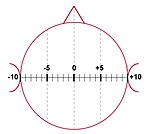Lateralization (acoustics)
If an auditory event occurs in the head of the listener when sound is presented through headphones , the term lateralization describes the lateral deflection of the auditory event.
Basics
A lateralization scale from −10 to +10 is used to describe the lateral deflection.
| −10 | means the auditory event is in the left ear. |
| +10 | means the auditory event is in the right ear. |
| 0 | means that the auditory event is located in the head on the median level , ie on the level between the two ears. |
Auditory events that do not occur exactly on the connection line between the two ears, but above / below or in front of / behind should be projected onto this connection line (dashed lines in the picture)
application
The determination of the lateralization z. B. in listening tests for directional hearing . The aim here is to research the effect of individual influencing factors on directional hearing, such as: B. Runtime differences between both ears , level differences between both ears , effects of direct sound and reflections, etc.
Such experiments are carried out with headphones , as they can be used to target the sound at both ears .
The test subject's task is almost always limited to describing the lateral deflection of the auditory events, projected onto a straight line connecting both ear canals. However, this “straight line” as the ear connection line given in research does not describe the listening location that sound engineers perceive primarily through headphones. An intensity stereophonic recording is not perceived on the straight line of lateralization, but this "line" is curved upwards so that mid-range sound sources appear to be elevated up to the top of the skull.
The advantage of this approach is that you can examine the effects of each effect that plays or could play a role in natural hearing independently of others. So you can z. B. examine the effect of level differences between the two ears without running time differences . This is not possible with natural hearing.
Since the sound in both ears deviates significantly from natural hearing , the hearing is no longer able to localize the sound outside the head: the auditory event is “localized” in the head. The lateralization scale (see above) was developed in order to provide test subjects with an aid to describe these auditory events in a comparable form.
Lateralization experiments thus provide information about the evaluation of interaural signal differences ( ITD and ILD ) by the auditory system , which arise in natural hearing through flexion, shadowing, transit times and resonances on the head and outer ears. By lateralization experiments with headphones one can examine these signal differences for their “effective” components.
From this, hypotheses about directional hearing can be developed, which can also be generalized to spatial hearing in a free sound field. The aim is to understand the mechanisms of hearing and ultimately to relate the in-head auditory events from lateralization experiments to the perceived directions of incidence in natural hearing.
The lateral deflection of a phantom sound source in loudspeaker stereophony is incorrectly referred to in some publications as lateralization. The correct word for this is of course localization.
literature
- Peter M. Pfleiderer: HIFI in a nutshell, playback technology for unadulterated hearing. 1st edition. Richard Pflaum Verlag, Munich 1990, ISBN 3-7905-0571-4 .
- Thomas Görne: Sound engineering. 1st edition. Carl Hanser Verlag, Leipzig 2006, ISBN 3-446-40198-9 .
- Hubert Henle: The recording studio manual. 5th edition. GC Carstensen Verlag, Munich 2001, ISBN 3-910098-19-3 .
See also
Web links
- Differentiate localization from lateralization (PDF file; 23 kB)
